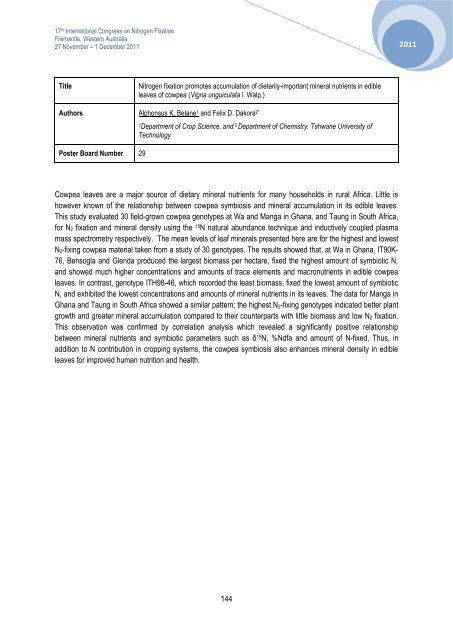IN INOCULANTS Nodulaid - 17th International Nitrogen Fixation ...
IN INOCULANTS Nodulaid - 17th International Nitrogen Fixation ...
IN INOCULANTS Nodulaid - 17th International Nitrogen Fixation ...
You also want an ePaper? Increase the reach of your titles
YUMPU automatically turns print PDFs into web optimized ePapers that Google loves.
17 th <strong>International</strong> Congress on <strong>Nitrogen</strong> <strong>Fixation</strong><br />
Fremantle, Western Australia<br />
27 November – 1 December 2011<br />
Title <strong>Nitrogen</strong> fixation promotes accumulation of dietarily-important mineral nutrients in edible<br />
leaves of cowpea (Vigna unguiculata l. Walp.)<br />
Authors Alphonsus K. Belane 1 and Felix D. Dakora 2*<br />
Poster Board Number 29<br />
1 Department of Crop Science, and 2 Department of Chemistry, Tshwane University of<br />
Technology<br />
Cowpea leaves are a major source of dietary mineral nutrients for many households in rural Africa. Little is<br />
however known of the relationship between cowpea symbiosis and mineral accumulation in its edible leaves.<br />
This study evaluated 30 field-grown cowpea genotypes at Wa and Manga in Ghana, and Taung in South Africa,<br />
for N2 fixation and mineral density using the 15 N natural abundance technique and inductively coupled plasma<br />
mass spectrometry respectively. The mean levels of leaf minerals presented here are for the highest and lowest<br />
N2-fixing cowpea material taken from a study of 30 genotypes. The results showed that, at Wa in Ghana, IT90K-<br />
76, Bensogla and Glenda produced the largest biomass per hectare, fixed the highest amount of symbiotic N,<br />
and showed much higher concentrations and amounts of trace elements and macronutrients in edible cowpea<br />
leaves. In contrast, genotype ITH98-46, which recorded the least biomass, fixed the lowest amount of symbiotic<br />
N, and exhibited the lowest concentrations and amounts of mineral nutrients in its leaves. The data for Manga in<br />
Ghana and Taung in South Africa showed a similar pattern; the highest N2-fixing genotypes indicated better plant<br />
growth and greater mineral accumulation compared to their counterparts with little biomass and low N2 fixation.<br />
This observation was confirmed by correlation analysis which revealed a significantly positive relationship<br />
between mineral nutrients and symbiotic parameters such as δ 15 N, %Ndfa and amount of N-fixed. Thus, in<br />
addition to N contribution in cropping systems, the cowpea symbiosis also enhances mineral density in edible<br />
leaves for improved human nutrition and health.<br />
144<br />
2011


